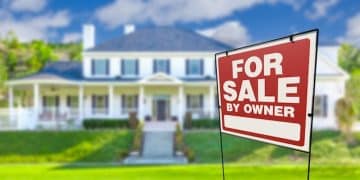Reverse Mortgages: Secure Your Retirement with This Guide

Reverse mortgages are loans available to homeowners 62 and older that allow them to convert a portion of their home equity into cash without selling their homes, providing financial security during retirement.
Navigating retirement finances can be challenging, but reverse mortgages: a comprehensive guide for seniors seeking financial security can offer a viable solution. This guide helps you understand how to leverage your home equity to improve your financial stability.
Understanding Reverse Mortgages
Reverse mortgages are designed specifically for homeowners aged 62 and older. They offer a way to access the equity built up in your home without the need to sell. Let’s explore the fundamentals of how these loans work, who qualifies, and what makes them different from traditional mortgages.
How Reverse Mortgages Work
Unlike traditional mortgages, where you make monthly payments to the lender, with a reverse mortgage, the lender makes payments to you. The loan, plus interest and fees, becomes due when you sell the home, move permanently, or pass away. Understanding this fundamental difference is essential for determining if a reverse mortgage aligns with your financial goals.
Eligibility Requirements
To qualify for a reverse mortgage, you must be at least 62 years old, own the home outright or have a low mortgage balance, and occupy the home as your primary residence. Additionally, you are required to maintain the property, pay property taxes, and homeowner’s insurance. Meeting these requirements ensures you can benefit from the loan without risking foreclosure.
- Age Requirement: Must be 62 years or older.
- Home Ownership: Own the home outright or have a low mortgage balance.
- Primary Residence: Occupy the home as your primary residence.
- Property Maintenance: Maintain the property and pay property taxes and homeowner’s insurance.
In essence, reverse mortgages provide a financial tool for seniors to tap into their home equity, offering a cash flow during retirement. Understanding the mechanics and requirements will enable you to make a well-informed decision.
Types of Reverse Mortgages Available
Several types of reverse mortgages are available, each with its own features and benefits. The most common type is the Home Equity Conversion Mortgage (HECM), which is insured by the U.S. Department of Housing and Urban Development (HUD). Let’s delve into the different options to help you determine which one suits your needs best.

Home Equity Conversion Mortgage (HECM)
HECM loans are insured by HUD and are the most widely used type of reverse mortgage. They offer flexibility as they can be used for any purpose, such as covering healthcare costs, supplementing income, or making home improvements. Because they are federally insured, HECMs come with certain protections and requirements.
Proprietary Reverse Mortgages
Proprietary reverse mortgages are offered by private lenders and are not insured by the federal government. These loans may be suitable for homeowners with higher-valued homes or those who need larger loan amounts than HECMs can provide. They often come with different terms and features, so it’s important to compare them carefully.
Navigating the landscape of reverse mortgage types requires a thorough understanding of the features, protections, and requirements associated with each. Armed with this knowledge, you can select the option that best aligns with your financial circumstances and long-term goals.
Benefits of Opting for a Reverse Mortgage
A reverse mortgage can offer numerous benefits to seniors seeking financial flexibility and security during retirement. From providing a source of income to eliminating monthly mortgage payments, the advantages can be significant. Let’s explore some of the key benefits in more detail.
Increased Financial Flexibility
One of the primary benefits of a reverse mortgage is the increased financial flexibility it provides. Seniors can use the funds to cover unexpected expenses, pay off debts, or simply enhance their quality of life. This added financial cushion can alleviate stress and provide peace of mind.
No Monthly Mortgage Payments
Unlike traditional mortgages, reverse mortgages do not require monthly payments. This can free up a significant portion of your monthly budget, allowing you to allocate those funds to other needs or desires. However, it’s crucial to continue paying property taxes and homeowner’s insurance to avoid default.
- Enhanced Quality of Life: Funds can be used to enjoy retirement more fully.
- Debt Management: Pay off high-interest debts.
- Home Improvements: Finance necessary home repairs.
- Healthcare Costs: Cover medical expenses.
Choosing a reverse mortgage can lead to greater financial stability and improved mental well-being, but it’s important to understand the implications and responsibilities associated with the loan.
Potential Drawbacks and Risks
While reverse mortgages can offer significant benefits, they also come with potential drawbacks and risks that you should carefully consider. Understanding these challenges will help you make an informed decision and avoid potential pitfalls. Let’s examine some of the key concerns.
Risk of Foreclosure
One of the most significant risks is the potential for foreclosure if you fail to meet the loan obligations. This includes paying property taxes, homeowner’s insurance, and maintaining the property. Falling behind on these responsibilities can lead to the lender initiating foreclosure proceedings.
Decreasing Home Equity
As the loan balance grows over time due to accrued interest and fees, your home equity decreases. This means there will be less equity available to pass on to your heirs or use for future financial needs. It’s crucial to factor in this reduction of equity when assessing the long-term impact of the loan.
Considering both the advantages and disadvantages of reverse mortgages is vital when evaluating if it aligns with your individual financial circumstances and long-term goals.
How to Apply for a Reverse Mortgage
Applying for a reverse mortgage involves several steps, from initial counseling to final loan disbursement. Understanding the process can help you navigate it more smoothly and ensure you meet all the necessary requirements. Let’s outline the key steps involved in securing a reverse mortgage.

Counseling Session
Before you can apply for a HECM loan, you are required to attend a counseling session with a HUD-approved counselor. The counselor will explain the terms of the loan, discuss your financial situation, and help you determine if a reverse mortgage is the right choice for you. This counseling is designed to protect borrowers and ensure they understand the implications of the loan.
Loan Application and Approval
Once you have completed the counseling session, you can proceed with the loan application. The lender will evaluate your eligibility, assess the value of your home, and determine the maximum loan amount you can borrow. If approved, you will receive a loan offer outlining the terms and conditions of the loan.
- Gather Financial Documents: Collect your financial records for the application.
- Obtain Property Appraisal: Get your home appraised to determine its value.
- Review Loan Terms: Carefully review the loan offer and terms.
- Close the Loan: Sign the loan documents and finalize the agreement.
The application process may seem complicated, but guidance from counselors and lenders can help you through each step.
Alternatives to Reverse Mortgages
While reverse mortgages can be a valuable financial tool, they are not the only option available to seniors seeking financial security. Exploring alternative strategies can help you identify the best solution for your unique circumstances. Let’s examine some of the alternatives.
Downsizing Your Home
Downsizing to a smaller, less expensive home can free up a significant amount of cash. This option allows you to tap into your home equity without taking on debt. The proceeds from the sale can be used to supplement your retirement income, pay off debts, or fund other financial needs.
Home Equity Line of Credit (HELOC)
A HELOC allows you to borrow against the equity in your home, providing a line of credit that you can use as needed. Unlike a reverse mortgage, a HELOC requires monthly payments and is subject to credit approval. This can be a useful option for those who need temporary access to funds and are comfortable with making regular payments.
Exploring these alternatives ensures informed decisions aligning with overall financial goals.
| Key Point | Brief Description |
|---|---|
| 🏡 Eligibility | Must be 62+, own the home, and live in it as your primary residence. |
| 💰 No Monthly Payments | Borrowers don’t make monthly payments, but still need to cover property taxes and insurance. |
| 📉 Decreasing Equity | Loan balance increases over time, reducing the equity in your home. |
| ⚖️ Counseling Required | Mandatory counseling with a HUD-approved agency ensures you understand the loan’s implications. |
[Reverse Mortgage FAQs]
A reverse mortgage is a loan available to homeowners 62 and older, allowing them to borrow against their home equity without selling their home. The borrower receives payments, and the loan is repaid when they move, sell the home, or pass away.
To qualify, you must be at least 62 years old, own the home outright or have a low mortgage balance, and occupy the home as your primary residence. You also need to maintain the property, pay property taxes, and homeowner’s insurance.
You retain ownership of your home with a reverse mortgage. However, you can lose the home if you fail to pay property taxes, homeowner’s insurance, or maintain the property, leading to foreclosure.
The loan amount is based on your age, the appraised value of your home, current interest rates, and the type of reverse mortgage you choose. Older homeowners with higher-valued homes generally qualify for larger loan amounts.
Yes, there are upfront costs, including an origination fee, mortgage insurance premium (for HECMs), appraisal fees, title insurance, and other closing costs. These costs can be financed as part of the loan.
Conclusion
Understanding the intricacies of reverse mortgages is crucial for seniors seeking financial security and flexibility in retirement. By carefully weighing the benefits and potential drawbacks, and exploring alternative options, you can make an informed decision that aligns with your individual circumstances and long-term goals.





